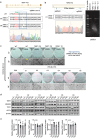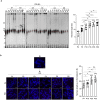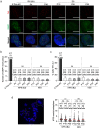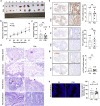Telomere dynamics in human pluripotent stem cells
- PMID: 38219218
- PMCID: PMC10936660
- DOI: 10.1080/15384101.2023.2285551
Telomere dynamics in human pluripotent stem cells
Abstract
Pluripotent stem cells (PSCs) are a promising source of stem cells for regenerative therapies. Stem cell function depends on telomere maintenance mechanisms that provide them with the proliferative capacity and genome stability necessary to multiply and regenerate tissues. We show here that established human embryonic stem cells (hESCs) have stable telomere length that is dependent on telomerase but not on alternative mechanisms based on homologous recombination pathways. Here, we show that human-induced pluripotent stem cells (hiPSCs) reprogrammed from somatic cells show progressive telomere lengthening until reaching a length similar to ESCs. hiPSCs also acquire telomeric chromatin marks of ESCs including decreased abundance of tri-methylated histone H3K9 and H4K20 and HP1 heterochromatic marks, as well as of the shelterin component TRF2. These chromatin features are accompanied with increased abundance of telomere transcripts or TERRAs. We also found that telomeres of both hESCs and hiPSCs are well protected from DNA damage during telomere elongation and once full telomere length is achieved, and exhibit stable genomes. Collectively, this study highlights that hiPSCs acquire ESC features during reprogramming and reveals the telomere biology in human pluripotent stem cells (hPSCs).
Keywords: Telomerase; Telomeres; hESCs; hiPSCs.
Plain language summary
We show that established human embryonic stem cells (hESCs) have a maximum and stable telomere length that is dependent on telomerase but not on the alternative homologous recombination pathway or ALT. Human-induced pluripotent stem cells (hiPSCs) reprogrammed from somatic cells show progressive telomere lengthening until reaching a length similar maximum telomere length than ESCs, suggesting that telomere length is regulated by epigenetic mechanisms in human cells. In this regard, hiPSCs acquire telomeric chromatin marks characteristic of an “open chromatin” including increased abundance of telomere transcripts or TERRAs. Telomeres of both hESCs and hiPSCs are well protected during telomere elongation and exhibit stable genomes. Collectively, this study highlights that hiPSCs acquire ESC features during reprogramming and reveals the telomere biology in human pluripotent stem cells (hiPSCs).
Conflict of interest statement
No potential conflict of interest was reported by the authors.
Figures






References
Publication types
MeSH terms
Substances
Grants and funding
LinkOut - more resources
Full Text Sources
Other Literature Sources
Research Materials
Miscellaneous
